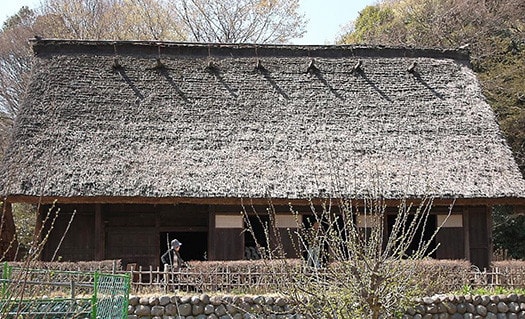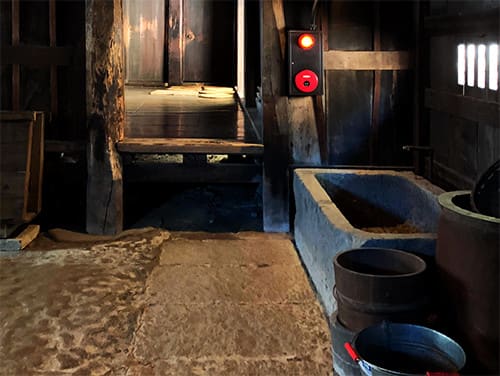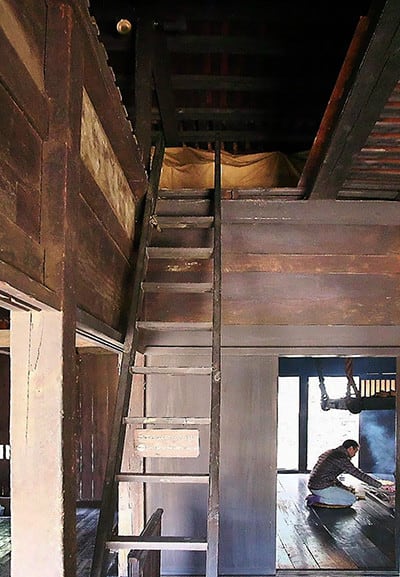


先日、この奥五箇山の合掌造りでの床高が写真確認できないと書きましたが
別の五箇山合掌造りの家のストック写真から、一番上の写真を発見。
たしかに「ふつうの利用」では合理的とは言えない床高と確認。
この床下空間で塩硝づくり工程が秘密裏に進められた可能性が高い。
ちょうど実証的な歴史小説作家・安部龍太郎の信長ものを読後なので、
戦国期の鉄砲伝来での軍事物資の最たるものである、
火薬と銃弾の「鉛」がほぼ輸入に頼っていたとされるテーマ。
浄土真宗の優勢な地域に於いて、軍事機密保持に最適な奥地で
このような製造工程が証拠づけられることが傍証されたかと。
〜織田信長と本願寺が争った石山合戦(1570年-1580年)では、五箇山産の
火薬の原料、塩硝(えんしょう)がすべて集められ、伏木(富山県高岡)から
海路でひそかに石山本願寺に送られ、本願寺のほかには
一切売らなかったと伝えられています。
ポルトガルから鉄砲が伝来したとされるのは1543年(諸説あり)。
火縄銃を大量に持ち操った織田信長が勝敗を決めたと言われる
長篠の戦いは1575年のこと。天然鉱石として降水量の多い日本では
ほとんど産出されなかった黒色火薬の原料、硝酸カリウムは、
織田信長とは異なるルートでその人工的な生産の方法が五箇山に伝わり、
改良されていったものと思われます。〜
五箇山総合案内所HPより要旨。
https://gokayama-info.jp/history/history.php
火薬の原料である焔硝(硝石)に対して人尿、蚕糞、野草などを材料とし、
土壌微生物のはたらきを利用してこの床下空間でつくったとされている。
合掌造りの家屋の床下で積極的に硝酸イオンを蓄積させた土、「硝酸土」を調整し、
それに対して化学反応変化を加えたのだというのです。
信長の側は貿易港・堺を抑えたけれど、ほかにも紀州雑賀でも
輸入があっただろうし、本願寺に至ってはこのような自国生産まで行っていた。
戦国末期の軍事情勢に非常に重大な影響を持っていたことでしょう。
織田軍とすれば堺を抑えたのに本願寺が不明のルートで
大量の火薬を持っていたことがなぜなのか解明できず、
そのことが石山合戦の長期化に繋がった可能性がある。
武器兵站を絶てば根枯れするはずが10年もしぶとく抵抗を続けられた。
蓮如がわざわざ奥地まで布教に訪れたのには、この軍事目的があったのだろう。
この旧山田家では、2階3階と養蚕施設も作られていた。
一般的な養蚕地域ではそのために桑を畑で栽培したが、
この五箇山奥地では山に自生する桑が利用されたといわれている。
この桑、蚕糞も床下での発酵工程に深く関わっていた・・・。
人里の交通路からかなり奥地の山中という自然を利用して
その風土に適した生業を考えて行くという営為の特殊形態として
日本民家には、このような知恵と工夫もあり得たということか。
階高の高い独特の外観形状が揃った古民家群として
雪深い地域自然景観と共生する合掌造りの、驚くべき生業ぶり。
そういえばそもそもこの地に根付いた初めが平家の落人伝承。
時代がかわり兵器の姿が変化したとしても、
その出自に於いて武人であることを考えれば、合理的選択肢なのかも。
English version⬇
[Gassho-zukuri gunpowder production and use / Japanese good house ㉚-6]
The other day, I wrote that the floor height of this Oku Gokayama gassho-zukuri cannot be confirmed in the photo.
I found the top photo from the stock photos of another Gokayama gassho-zukuri house.
Certainly, it was confirmed that the floor height was not rational for "normal use".
It is highly possible that the saltpeter making process was secretly carried out in this underfloor space.
Just after reading Nobunaga's empirical historical novel writer Ryutaro Abe,
The best military supplies in the introduction of guns during the Warring States period,
It is said that the "lead" of gunpowder and bullets relied mostly on imports.
In the predominant area of Jodo Shinshu, in the best hinterland for military secrets
Was it evidenced that such a manufacturing process could be proved?
~ In the Ishiyama Battle (1570-1580), where Nobunaga Oda and Honganji fought, the products from Gokayama
All the raw materials for gunpowder, saltpeter, are collected from Fushiki (Takaoka, Toyama Prefecture).
It was secretly sent to Ishiyama Hongan-ji Temple by sea, and besides Hongan-ji Temple
It is reported that they did not sell at all.
It is said that guns were introduced from Portugal in 1543 (there are various theories).
It is said that Nobunaga Oda, who carried a large number of matchlock guns, decided the victory or defeat.
The battle of Nagashino was in 1575. In Japan, where there is a lot of rainfall as a natural ore
Potassium nitrate, a raw material for black powder that was rarely produced,
The artificial production method was transmitted to Gokayama by a route different from that of Oda Nobunaga.
It seems that it was improved. ~
Summary from the Gokayama General Information Center website.
https://gokayama-info.jp/history/history.php
Human urine, silk moth feces, wild grass, etc. are used as materials for flame glass (nitre), which is the raw material of gunpowder.
It is said that it was created in this underfloor space using the function of soil microorganisms.
Adjusting "nitrate soil", the soil that actively accumulated nitrate ions under the floor of a gassho-style house,
On the other hand, the chemical reaction was changed.
Nobunaga's side suppressed the trading port Sakai, but also in Kishu Saika
There would have been imports, and even Honganji had such domestic production.
It would have had a very significant impact on the military situation at the end of the Warring States period.
For the Oda army, Sakai was suppressed, but Honganji was on an unknown route.
I couldn't figure out why I had a lot of gunpowder,
That may have led to the prolongation of the Ishiyama battle.
If the weapons logistics were cut off, the roots would die, but the resistance continued for 10 years.
It is probably because of this military purpose that Rennyo purposely visited the hinterland for missionary work.
In this former Yamada family, sericulture facilities were also built on the 2nd and 3rd floors.
In general sericulture areas, mulberry was cultivated in the fields for that purpose,
It is said that mulberry that grows naturally in the mountains was used in the interior of Gokayama.
These mulberry and silk moth droppings were also deeply involved in the fermentation process under the floor.
Taking advantage of the nature of the mountains in the remote areas from the remote traffic routes
As a special form of business to think about a livelihood suitable for that climate
Does it mean that Japanese private houses could have such wisdom and ingenuity?
As a group of old folk houses with a unique exterior shape with high floors
An amazing livelihood with a gassho-style structure that coexists with the natural landscape of the snowy region.
Speaking of which, the beginning of Heike's folklore has taken root in this area.
Even if the times change and the appearance of weapons changes
Considering that he is a warrior in his origin, it may be a rational option.










